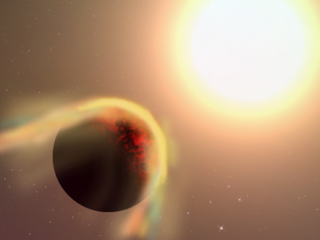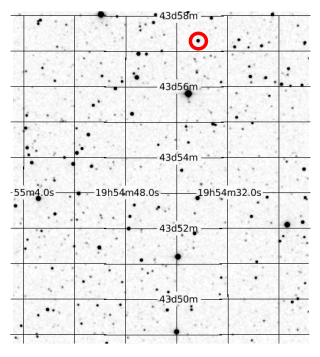This page describes exoplanet orbital and physical parameters.

Kepler-10, formerly known as KOI-72, is a Sun-like star in the constellation of Draco that lies 607 light-years from Earth. Kepler-10 was targeted by NASA's Kepler spacecraft, as it was seen as the first star identified by the Kepler mission that could be a possible host to a small, transiting exoplanet. The star is slightly less massive, slightly larger, and slightly cooler than the Sun; at an estimated 11.9 billion years in age, Kepler-10 is almost 2.6 times the age of the Sun. Kepler-10 is host to a planetary system made up of at least three planets. Kepler-10b, the first undeniably rocky planet, was discovered in its orbit after eight months of observation and announced on January 10, 2011. The planet orbits its star closely, completing an orbit every 0.8 days, and has a density similar to that of iron. The second planet, Kepler-10c, was confirmed on May 23, 2011, based on follow-up observations by the Spitzer Space Telescope. The data shows it has an orbital period of 42.3 days and has a radius more than double that of Earth, but it was initially thought to have a higher density, making it the largest and most massive rocky planet discovered as of June 2014. However, refined mass measurements have shown it to be a more typical volatile-rich planet. A third planet, Kepler-10d, was discovered in 2023 by radial velocity observations.

Kepler-11c is an exoplanet discovered in the orbit of the Sun-like star Kepler-11 by the Kepler spacecraft, a NASA telescope aiming to discover Earth-like planets. It is the second planet from its star, and is most likely a water planet with a thin hydrogen–helium atmosphere. Kepler-11c orbits Kepler-11 every 10 days, and has an estimated density twice that of pure water. It is estimated to have a mass thirteen times that of Earth and a radius three times that of Earth. Kepler-11c and its five sister planets form the first discovered system with more than three transiting planets. The Kepler-11 system also holds the record of being the most compact and the flattest system discovered. Kepler-11c and the other Kepler-11 planets were announced to the public on February 2, 2011, and was published in Nature a day later.

Kepler-70b is one of two postulated exoplanets orbiting the subdwarf B star (sdB) Kepler-70. The other planet is Kepler-70c, and both planets orbit very close to their host star.
Kepler-1520 is a K-type main-sequence star located in the constellation Cygnus. The star is particularly important, as measurements taken by the Kepler spacecraft indicate that the variations in the star's light curve cover a range from about 0.2% to 1.3% of the star's light being blocked. This indicates that there may be a rapidly disintegrating planet, a prediction not yet conclusively confirmed, in orbit around the star, losing mass at a rate of 1 Earth mass every billion years. The planet itself is about 0.1 Earth masses, or just twice the mass of Mercury, and is expected to disintegrate in about 100-200 million years. The planet orbits its star in just 15.7 hours, at a distance only two stellar diameters away from the star's surface, and has an estimated effective temperature of about 2255 K. The orbital period of the planet is one of the shortest ever detected in the history of the extrasolar planet search. In 2016, the planet was confirmed as part of a data release by the Kepler spacecraft.

Kepler-69 is a G-type main-sequence star similar to the Sun in the constellation Cygnus, located about 2,430 ly (750 pc) from Earth. On April 18, 2013 it was announced that the star has two planets. Although initial estimates indicated that the terrestrial planet Kepler-69c might be within the star's habitable zone, further analysis showed that the planet very likely is interior to the habitable zone and is far more analogous to Venus than to Earth and thus completely inhospitable.
Kepler-62c is an approximately Mars-sized exoplanet discovered in orbit around the star Kepler-62, the second innermost of five discovered by NASA's Kepler spacecraft around Kepler-62. At the time of discovery it was the second-smallest exoplanet discovered and confirmed by the Kepler spacecraft, after Kepler-37b. It was found using the transit method, in which the dimming that a planet causes as it crosses in front of its star is measured. Its stellar flux is 25 ± 3 times Earth's. It is similar to Mercury.

Kepler-78b is an exoplanet orbiting around the star Kepler-78. At the time of its discovery, it was the exoplanet most similar to Earth in terms of mass, radius, and mean density.
Kepler-70c is one of two postulated exoplanets orbiting the sdB star Kepler-70. Their discovery was announced in 2011. However, later research suggests that the two exoplanets probably do not exist, and that "pulsation modes visible beyond the cut-off frequency of the star" were a more likely explanation for the signals believed to indicate exoplanets. This is not proven with certainty one way or the other.

Kepler-90g is a super-puff exoplanet orbiting the early G-type main sequence star Kepler-90, one of eight planets around this star discovered using NASA's Kepler space telescope. It is located about 2,840 light-years (870 pc) from Earth, in the constellation Draco. The exoplanet was found by using the transit method, in which the dimming effect that a planet causes as it crosses in front of its star is measured. It orbits its parent star about every 210.5 days at a distance of 0.71 astronomical units.
Kepler-61 is a K-type main-sequence star approximately 1,100 light years from Earth in the constellation Cygnus. It is located within the field of vision of the Kepler spacecraft, the satellite that NASA's Kepler Mission used to detect planets that may be transiting their stars. On April 24, 2013 it was announced that the star has an extrasolar planet orbiting in the inner edge of the habitable zone, named Kepler-61b.

Kepler-186 is a main-sequence M1-type dwarf star, located 178.5 parsecs away in the constellation of Cygnus. The star is slightly cooler than the sun, with roughly half its metallicity. It is known to have five planets, including the first Earth-sized world discovered in the habitable zone: Kepler-186f. The star hosts four other planets discovered so far, though they all orbit interior to the habitable zone.

Kepler-186f is an Earth-sized exoplanet orbiting within the habitable zone of the red dwarf star Kepler-186, the outermost of five such planets discovered around the star by NASA's Kepler spacecraft. It is located about 580 light-years from Earth in the constellation of Cygnus.
Kepler-432b (also known by its Kepler Object of Interest designation KOI-1299.01) is a hot super-Jupiter (or "warm" super-Jupiter) exoplanet orbiting the giant star Kepler-432 A, the innermost of two such planets discovered by NASA's Kepler spacecraft. It is located about 2,830 light-years (870 parsecs, or nearly 2.684×1016 km) from Earth in the constellation Cygnus. The exoplanet was found by using the transit method, in which the dimming effect that a planet causes as it crosses in front of its star is measured.

Kepler-452 is a G-type main-sequence star located about 1,800 light-years away from Earth in the Cygnus constellation. Although similar in temperature to the Sun, it is 20% brighter, 3.7% more massive and 11% larger. Alongside this, the star is approximately six billion years old and possesses a high metallicity. Thus, Kepler-452 can be considered a solar twin, although it could be considered a solar analog due to its age.
Kepler-186e is a confirmed exoplanet orbiting the red dwarf star Kepler-186, approximately 582 light years away from Earth in the constellation of Cygnus. It is near the optimistic habitable zone but probably not in it, possibly making it have a runaway greenhouse effect, like Venus. The exoplanet was found by using the transit method, in which the dimming effect that a planet causes as it crosses in front of its star is measured. Four additional planets orbiting the star were also discovered.

Kepler-1229b is a confirmed super-Earth exoplanet, likely rocky, orbiting within the habitable zone of the red dwarf Kepler-1229, located about 870 light years from Earth in the constellation of Cygnus. It was discovered in 2016 by the Kepler space telescope. The exoplanet was found by using the transit method, in which the dimming effect that a planet causes as it crosses in front of its star is measured.

K2-33b is a very young super-Neptune exoplanet, orbiting the pre-main-sequence star K2-33. It was discovered by NASA's Kepler spacecraft on its "Second Light" mission. It is located about 456 light-years away from Earth in the constellation of Scorpius. The exoplanet was found by using the transit method, in which the dimming effect that a planet causes as it crosses in front of its star is measured.
Kepler-1229 is a red dwarf star located about 870 light-years (270 pc) away from the Earth in the constellation of Cygnus. It is known to host a super-Earth exoplanet within its habitable zone, Kepler-1229b, which was discovered in 2016.

WD 1145+017 b, is a confirmed exoplanetary object, likely rocky, orbiting around and being vaporized by the white dwarf star WD 1145+017. It was discovered by NASA's Kepler spacecraft on its "Second Light" mission. It is located about 570 light-years away from Earth in the constellation of Virgo. The object was found by using the transit method, in which the dimming effect that a planet causes as it crosses in front of its star is measured.
















